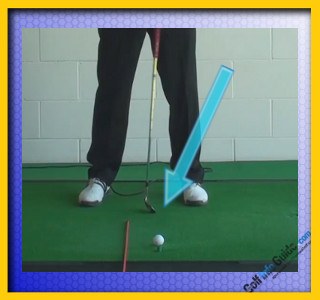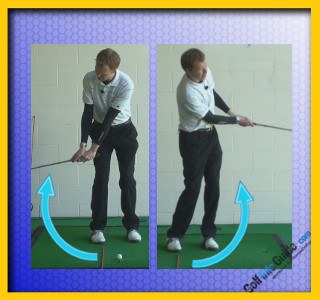
For most golfers chipping can be a very frustrating part of the game. This is mainly due to two reasons; one not striking the ball well and two, not being able to hit the ball the correct distance to the hole.
Firstly, we need to strike the ball correctly by hitting downwards through the ball into the ground. This ensures good, correct contact with the ball and makes the ball roll up the club face, meaning that the loft of the golf club pops the ball up into the air. If we are doing this correctly then we should see a slight divot in front of where the ball sat. If this is not happening and the golfer is flicking upwards through the golf ball, we will see a tendency to hit the ground first before the ball, where the ball will only travel a few yards and not make the green. Alternatively, we will see the bottom edge of the golf club hit halfway up the golf ball, sending the ball very low and very fast, often across and over the back of the green.
To help us with this problem, we are going to position one of our tour sticks approximately two to three inches behind the golf ball. Set up slightly differently to a normal shot by making sure that the position of the body weight is set so that 70 percent is on the front foot and that the hands are positioned in front of the golf ball, roughly opposite to the front knee. This set up position encourages the objective of the drill, which is to strike down and through the ball, missing the tour stick and hitting the ground after the golf ball, which will produce a good ball strike.

The second tour stick needs to be positioned on the nearest, flattest area of the green. This identifies the landing area for the golf ball, which is a rough three foot square, where the golf ball would ideally land and then roll out to the flag. Using the stick in this way helps to focus on a large area of ground rather than focus on a four and a half inch hole. This is a more realistic aim to achieve and helps to take the pressure off the shot in hand. This also helps the understanding of how using different clubs can affect the length of the chip shot.
In an ideal world, one chipping action should be used consistently rather than modifying the action each time a different length of shot is needed. This allows the use of different golf clubs rather than different techniques to get the ball to land in the correct spot and roll to the hole. As a good guideline, with a properly struck chip shot, a lob wedge will carry in the air approximately 80 percent of the distance to the hole and will roll the last 20 percent. A pitching wedge will carry approximately 50 percent and will roll 50 percent, while an 8 iron will carry approximately 20 percent and will roll 80 percent of the distance to the hole.
In practice, vary the length of the shot and use the tour sticks to help estimate and visualise how much carry and roll each club will produce, so that all of the golf clubs can be used to maximum effect. This drill allows much more consistent distance control and helps to focus on the striking of the golf ball.






